Gangwon
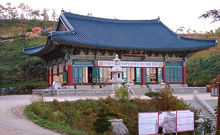
This is a list of Buddhist temples, monasteries, stupas, and pagodas' in South Korea for which there are Wikipedia articles, sorted by location.

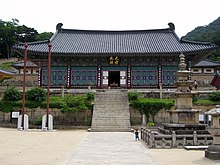


A pagoda is an East Asian tiered tower with multiple eaves common to Nepal, China, Japan, Korea, Myanmar, Vietnam, and other parts of Asia. Most pagodas were built to have a religious function, most often Buddhist but sometimes Taoist, and were often located in or near viharas. The pagoda traces its origins to the stupa of ancient India.
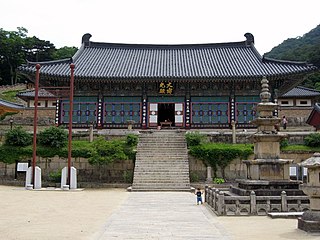
Haeinsa is a head temple of the Jogye Order of Korean Seon Buddhism in Gayasan National Park, South Gyeongsang Province, South Korea. Haeinsa is most notable for being the home of the Tripitaka Koreana, the whole of the Buddhist Scriptures carved onto 81,350 wooden printing blocks, which it has housed since 1398.
Buddhist temples are an important part of the Korean landscape. This article gives a brief overview of Korean Buddhism, then describes some of the more important temples in Korea. Most Korean temples have names ending in -sa, which means "temple" in Sino-Korean.
The Three Jewels Temples are the three principal Buddhist temples in Korea, each representing one of the Three Jewels of Buddhism, and all located in South Korea.

Bulguksa is located on the slopes of Mount Toham. It is a head temple of the Jogye Order of Korean Buddhism and encompasses six National treasures of South Korea, including the Dabotap and Seokgatap stone pagodas, Cheongun-gyo, and two gilt-bronze statues of Buddha. The temple is classified as Historic and Scenic Site No. 1 by the South Korean government. In 1995, Bulguksa was added to the UNESCO World Heritage List together with the Seokguram Grotto, which lies four kilometers to the east.

Tongdosa is a head temple of the Jogye Order of Korean Buddhism and in the southern part of Mt. Chiseosan near Yangsan, South Gyeongsang Province, South Korea.

Mireuksa was the largest Buddhist temple in the ancient Korean kingdom of Baekje. The temple was established in 602 by King Mu and is located 36.012083 N, 127.031028 E, modern Iksan, North Jeolla Province, South Korea. The site was excavated in 1980, disclosing many hitherto unknown facts about Baekje architecture. Mireuksaji Stone Pagoda is one of two extant Baekje pagodas. It is also the largest as well as being among the oldest of all Korean pagodas.
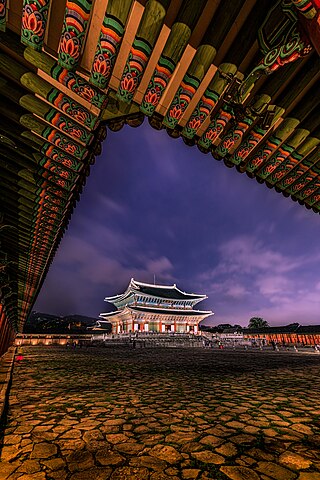
Korean architecture refers to an architectural style that developed over centuries in Korea. Throughout the history of Korea, various kingdoms and royal dynasties have developed a unique style of architecture with influences from Buddhism and Korean Confucianism.

Hwangnyongsa, or Hwangnyong Temple was a Buddhist temple in the city of Gyeongju, South Korea.
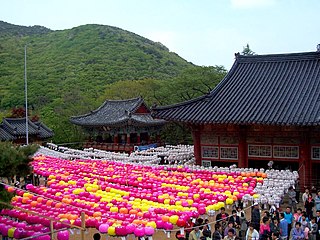
Beomeosa is a head temple of the Jogye Order of Korean Buddhism in Cheongnyong-dong, Geumjeong-gu, Busan, South Korea. Built on the slopes of Geumjeongsan, it is one of the country's best known urban temples.

Woljeongsa is a head temple of the Jogye Order of Korean Buddhism, located on the eastern slopes of Odaesan in Pyeongchang County, Gangwon Province, South Korea. Woljeongsa was founded in 643 by the Silla monk Jajang.

Geumsansa is a temple of the Jogye Order of Korean Buddhism standing on the slopes of Moaksan in Gimje City, Jeollabuk-do, South Korea.
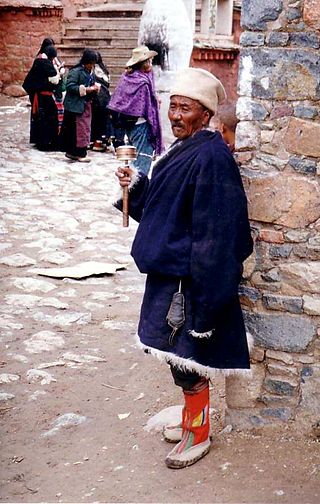
The most important places in Buddhism are located in the Indo-Gangetic Plain of northern India and southern Nepal, in the area between New Delhi and Rajgir. This is the area where Gautama Buddha lived and taught, and the main sites connected to his life are now important places of pilgrimage for both Buddhists and Hindus. Many countries that are or were predominantly Buddhist have shrines and places which can be visited as a pilgrimage.

Shilleuksa is a Korean Buddhist temple situated against a low hill on the north side of the river Namhan, three kilometers east of Yeoju in Gyeonggi Province, approximately one-hour southeast of Seoul. The only riverside temple in South Korea, Shilleuksa is a sacred pilgrimage site and a repository of seven Treasures. A 500-year-old aromatic juniper tree and a 600-year-old ginkgo tree stand on the temple grounds.

Shichidō garan is a Japanese Buddhist term indicating the seven halls composing the ideal Buddhist temple compound. This compound word is composed of shichidō (七堂), literally meaning "seven halls", and garan (伽藍), meaning "temple". The term is often shortened to just garan. Which seven halls the term refers to varies, and 七堂 may be a misinterpretation of shitsudō (悉堂), meaning "complete temple". In practice, shichidō garan often simply means a large temple with many buildings.
Pagodas in Japan are called tō, sometimes buttō or tōba and historically derive from the Chinese pagoda, itself an interpretation of the Indian stupa. Like the stupa, pagodas were originally used as reliquaries but in many cases they ended up losing this function. Pagodas are quintessentially Buddhist and an important component of Japanese Buddhist temple compounds but, because until the Kami and Buddhas Separation Act of 1868, a Shinto shrine was normally also a Buddhist temple and vice versa, they are not rare at shrines either. The famous Itsukushima Shrine, for example, has one.

According to the Mahāparinibbāṇa Sutta, after attaining parinirvana, the body of Buddha was cremated and the ashes divided among his lay followers.

The Kwangbop Temple is an historic structure located in Mt. Taesong, Pyongyang, North Korea. Built during the early period of Koguryo during the reign of King Kwanggaetho, it is listed as item 164 on the list of National Treasures of North Korea.